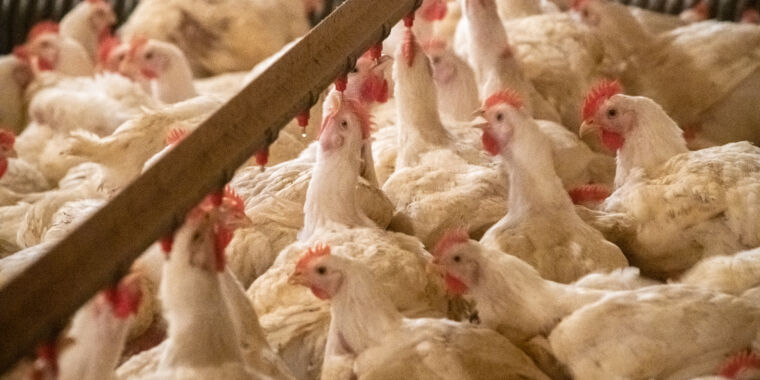Highly pathogenic avian influenza H5N1 virus leaked from wild birds US dairy cows Late last year, the virus leaked from a Colorado dairy farm to a nearby chicken farm, possibly infecting five workers who were helping to cull infected chickens.
Four of the bird flu cases have been confirmed by the Centers for Disease Control and Prevention, while the fifth has tentatively tested positive, pending confirmation from the CDC, federal officials reported at a press conference on Tuesday.
All five patients had mild symptoms, but symptoms varied. Some cases included conjunctivitis, Other human cases associated with H5N1 infection in dairy cowsThe other five people in the cluster had respiratory and typical flu-like symptoms, including fever, chills, sore throat, runny nose and cough. None of the five required hospitalization.
The virus that infected the five people is closely related to one found in chickens on the poultry farm, which is in turn closely related to viruses seen in infected dairy herds and other human cases linked to spread among dairy cows. The infected poultry farm is located in Weld County in northern Colorado, where cases have also been reported. Approximately 20 cases of avian influenza in dairy herds.
The dairy-to-chicken hypothesis
The outbreak at a Colorado chicken farm has more than doubled human cases of avian influenza linked to dairy cow spills. This increases from four to nine.Officials have previously noted cases where H5N1 on dairy farms appears to have spread to nearby chicken farms, but this appears to be the first time such an outbreak has been documented to have led to human infections.
The link between the chicken farm cases and the nearby dairy farm is still just a hypothesis, CDC Principal Deputy Director Nirav Shah stressed to reporters on Tuesday. “It’s a hypothesis that needs to be fully investigated, but at this point it’s just a hypothesis,” he said of the link between the dairy farm and the chicken farm. As of now, there is no direct evidence to pinpoint the source of the infection at the chicken farm, and the route of infection is unknown.
As H5N1 outbreaks at dairy farms continue, officials have suggested the primary way the virus spreads to new farms is through the movement of cows, people, and machinery between facilities. There is no evidence of human-to-human transmission yet. But milk from infected cows has been found to be rife with high concentrations of the infectious virus, making equipment contaminated by the milk a prime suspect for spreading the disease.
Eric Deeble, USDA’s acting senior adviser for H5N1 response, noted at a press conference on Tuesday that poultry are highly susceptible to avian influenza and can easily become infected. “It doesn’t take much to introduce this virus into a flock,” Deeble said. USDA is currently conducting a “retrospective” investigation into how the Colorado chicken farm became infected.
A searing spread
As for how specifically the farm workers contracted the virus, health officials pointed to high temperatures that prevented workers from wearing protective clothing. The farm is a commercial egg-laying farm, with around 1.8 million chickens. Due to an outbreak of avian influenza on the premises, all 1.8 million chickens need to be killed, or “culled”. This is being done using mobile carts equipped with carbon dioxide gas chambers, a common culling method. Workers are tasked with placing the chickens into chambers that can only hold a few dozen at a time. Overall, this method requires workers to move from bird to bird and batch to batch on the carts, bringing them into frequent contact with infected birds.
During this grueling operation, temperatures at the site exceeded 100 degrees Fahrenheit, and the facility’s giant industrial fans were turned on to cool it down. The heat and the fans made it difficult for the approximately 160 people involved in the extermination effort to use their personal protective equipment (PPE), which includes full Tyvek suits, boots, gloves, goggles, and N95 masks.
“You can imagine how difficult it would be to wear all that gear in that heat,” said Julie Gauthier, executive director of field operations for the USDA’s Animal and Plant Health Inspection Service (APHIS). Industrial fans blowing huge volumes of air made it even harder for workers to keep goggles and gas masks on their faces, she said.
Both the CDC and USDA are further investigating the outbreak at the poultry plant, and the CDC’s Shah noted that the team sent to Colorado includes industrial hygienists so they can come up with strategies to prevent further spread.
At least to date 161 herds in 13 states The first cases of avian influenza have tested positive since a dairy outbreak was identified in March, and the first cases since a U.S. bird first tested positive for the H5N1 virus in January 2022. 99 million birds in the United States The disease has spread to 48 states, with 1,165 cases.


